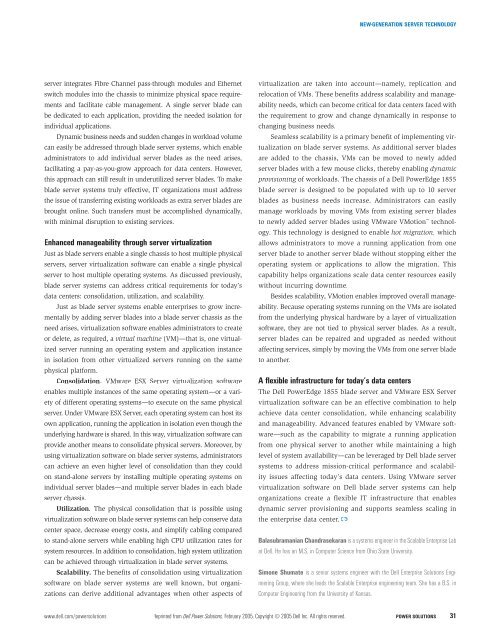Dell Power Solutions
Dell Power Solutions
Dell Power Solutions
- No tags were found...
You also want an ePaper? Increase the reach of your titles
YUMPU automatically turns print PDFs into web optimized ePapers that Google loves.
NEW-GENERATION SERVER TECHNOLOGYserver integrates Fibre Channel pass-through modules and Ethernetswitch modules into the chassis to minimize physical space requirementsand facilitate cable management. A single server blade canbe dedicated to each application, providing the needed isolation forindividual applications.Dynamic business needs and sudden changes in workload volumecan easily be addressed through blade server systems, which enableadministrators to add individual server blades as the need arises,facilitating a pay-as-you-grow approach for data centers. However,this approach can still result in underutilized server blades. To makeblade server systems truly effective, IT organizations must addressthe issue of transferring existing workloads as extra server blades arebrought online. Such transfers must be accomplished dynamically,with minimal disruption to existing services.Enhanced manageability through server virtualizationJust as blade servers enable a single chassis to host multiple physicalservers, server virtualization software can enable a single physicalserver to host multiple operating systems. As discussed previously,blade server systems can address critical requirements for today’sdata centers: consolidation, utilization, and scalability.Just as blade server systems enable enterprises to grow incrementallyby adding server blades into a blade server chassis as theneed arises, virtualization software enables administrators to createor delete, as required, a virtual machine (VM)—that is, one virtual-ized server running an operating system and application instancein isolation from other virtualized servers running on the samephysical platform.Consolidation. VMware ESX Server virtualization softwareenables multiple instances of the same operating system—or a varietyof different operating systems—to execute on the same physicalserver. Under VMware ESX Server, each operating system can host itsown application, running the application in isolation even though theunderlying hardware is shared. In this way, virtualization software canprovide another means to consolidate physical servers. Moreover, byusing virtualization software on blade server systems, administratorscan achieve an even higher level of consolidation than they couldon stand-alone servers by installing multiple operating systems onindividual server blades—and multiple server blades in each bladeserver chassis.Utilization. The physical consolidation that is possible usingvirtualization software on blade server systems can help conserve datacenter space, decrease energy costs, and simplify cabling comparedto stand-alone servers while enabling high CPU utilization rates forsystem resources. In addition to consolidation, high system utilizationcan be achieved through virtualization in blade server systems.Scalability. The benefits of consolidation using virtualizationsoftware on blade server systems are well known, but organizationscan derive additional advantages when other aspects ofvirtualization are taken into account—namely, replication andrelocation of VMs. These benefits address scalability and manageabilityneeds, which can become critical for data centers faced withthe requirement to grow and change dynamically in response tochanging business needs.Seamless scalability is a primary benefit of implementing virtualizationon blade server systems. As additional server bladesare added to the chassis, VMs can be moved to newly addedserver blades with a few mouse clicks, thereby enabling dynamicprovisioning of workloads. The chassis of a <strong>Dell</strong> <strong>Power</strong>Edge 1855blade server is designed to be populated with up to 10 serverblades as business needs increase. Administrators can easilymanage workloads by moving VMs from existing server bladesto newly added server blades using VMware VMotion technology.This technology is designed to enable hot migration, whichallows administrators to move a running application from oneserver blade to another server blade without stopping either theoperating system or applications to allow the migration. Thiscapability helps organizations scale data center resources easilywithout incurring downtime.Besides scalability, VMotion enables improved overall manageability.Because operating systems running on the VMs are isolatedfrom the underlying physical hardware by a layer of virtualizationsoftware, they are not tied to physical server blades. As a result,server blades can be repaired and upgraded as needed withoutaffecting services, simply by moving the VMs from one server bladeto another.A flexible infrastructure for today’s data centersThe <strong>Dell</strong> <strong>Power</strong>Edge 1855 blade server and VMware ESX Servervirtualization software can be an effective combination to helpachieve data center consolidation, while enhancing scalabilityand manageability. Advanced features enabled by VMware software—suchas the capability to migrate a running applicationfrom one physical server to another while maintaining a highlevel of system availability—can be leveraged by <strong>Dell</strong> blade serversystems to address mission-critical performance and scalabilityissues affecting today’s data centers. Using VMware servervirtualization software on <strong>Dell</strong> blade server systems can helporganizations create a flexible IT infrastructure that enablesdynamic server provisioning and supports seamless scaling inthe enterprise data center.Balasubramanian Chandrasekaran is a systems engineer in the Scalable Enterprise Labat <strong>Dell</strong>. He has an M.S. in Computer Science from Ohio State University.Simone Shumate is a senior systems engineer with the <strong>Dell</strong> Enterprise <strong>Solutions</strong> EngineeringGroup, where she leads the Scalable Enterprise engineering team. She has a B.S. inComputer Engineering from the University of Kansas.www.dell.com/powersolutions Reprinted from <strong>Dell</strong> <strong>Power</strong> <strong>Solutions</strong>, February 2005. Copyright © 2005 <strong>Dell</strong> Inc. All rights reserved. POWER SOLUTIONS 31








